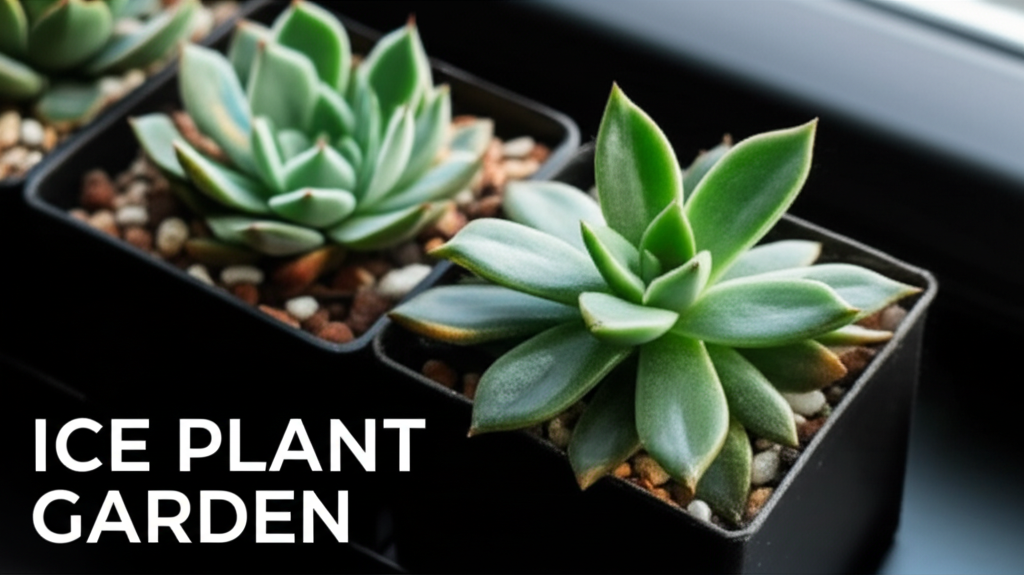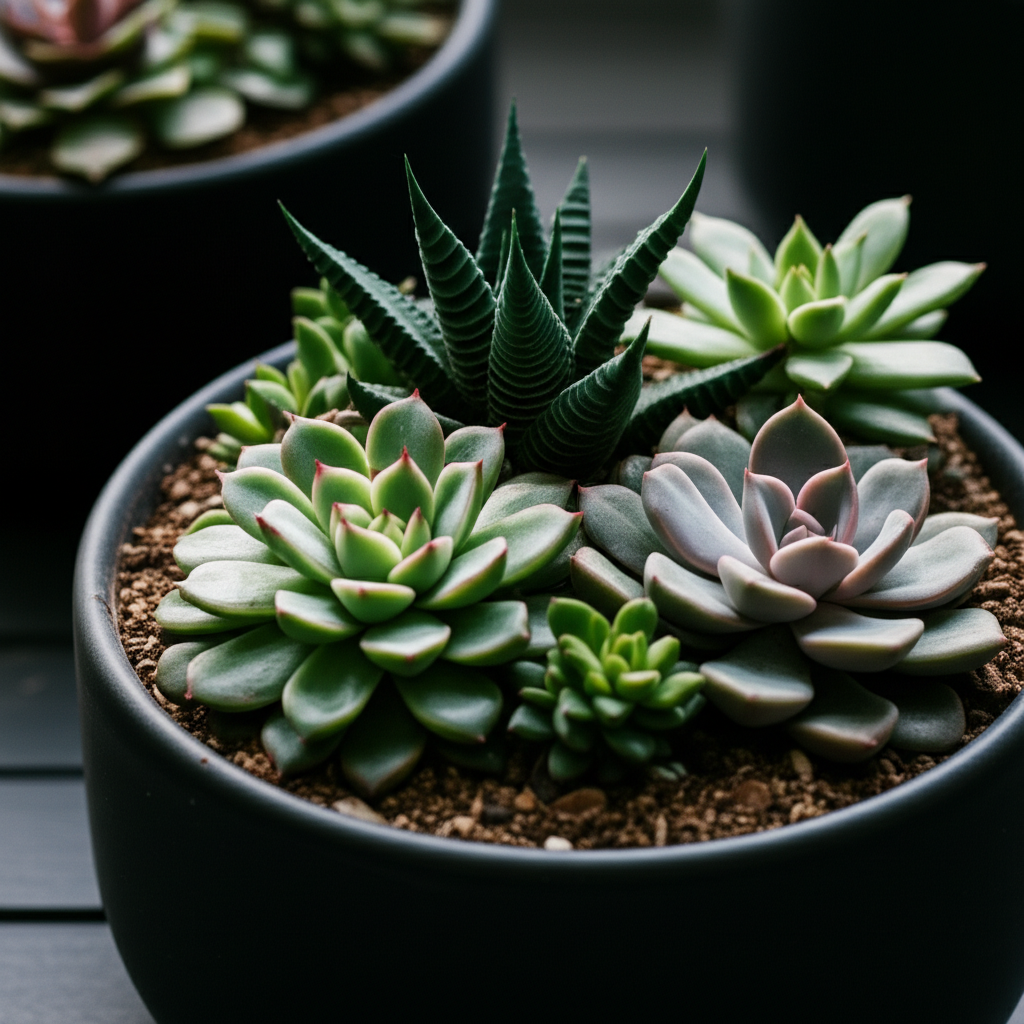Introduction: Bringing a Touch of Frosty Green Indoors
In the realm of indoor gardening, succulents have carved out a significant niche, celebrated for their resilience, unique aesthetics, and low-maintenance appeal. Among these fascinating plants, the Ice Plant family (Mesembryanthemaceae) offers a particularly captivating option for creating miniature indoor gardens. Often characterized by their distinctive, bladder-like epidermal cells that glisten like frost, these succulents bring a touch of the unusual and the beautiful to any tabletop. This article delves into the art of cultivating a tiny ice plant succulent garden, exploring the varieties best suited for indoor tabletop display, essential care requirements, design considerations, and the sheer joy of nurturing a miniature desert oasis within your living space.
Why Choose Tiny Ice Plants for Your Indoor Garden?

The appeal of ice plants for indoor tabletop gardens is multifaceted. Their compact growth habits, diverse textures, and remarkable drought tolerance make them ideal companions for smaller spaces and busy individuals. The “ice” or “dew” they produce isn’t actual water but specialized cells that reflect light, giving them a shimmering, frosted appearance that is truly mesmerizing. This unique characteristic sets them apart from other succulents, offering a dynamic visual element to your decor. Furthermore, their minimal water and light needs translate into an easy-to-manage and rewarding gardening experience.
Key Characteristics of Ice Plants Suitable for Tabletop Gardens
- Compact Growth: Many ice plant species naturally grow close to the ground or form small, dense mats, preventing them from outgrowing confined spaces.
- Drought Tolerance: Like most succulents, ice plants store water in their leaves and stems, requiring infrequent watering.
- Unique Textures: The characteristic “ice” cells provide a unique tactile and visual appeal, often giving them a sparkling, almost crystalline appearance.
- Adaptability: While they thrive in bright light, many can tolerate slightly lower light conditions than some other succulents, making them more forgiving for indoor environments.
- Varied Forms: From ground-hugging varieties to those with more upright growth, there’s a surprising diversity within the ice plant family to suit different aesthetic preferences.
Selecting the Right Ice Plants for Your Miniature Garden
Not all ice plants are created equal when it comes to indoor tabletop cultivation. The key is to choose species that naturally maintain a smaller size and don’t require extensive pruning to stay manageable. Here are some excellent choices, along with their defining characteristics:
Popular Ice Plant Varieties for Tabletop Gardens
Delosperma (Ice Plant ‘Cooperi’ and its Relatives
Delosperma species, often referred to as hardy ice plants, are renowned for their vibrant, daisy-like flowers and succulent foliage. While some varieties can spread, many can be kept contained in small pots. They are particularly appreciated for their prolific blooming, which can add a burst of color to your indoor display.
Lithops (Living Stones)
While technically a different family (Aizoaceae), Lithops are often grouped with ice plants due to their superficial resemblance and unique succulent adaptations. These fascinating plants mimic pebbles, with most of their body consisting of two fused leaves. They are extremely slow-growing and require very careful watering, making them a low-maintenance yet captivating addition.
Pleiospilos (Split Rock Succulents)
Another succulent that shares a similar aesthetic with ice plants and Lithops, Pleiospilos also resemble stones. They have thick, triangular leaves that split open, revealing new growth. Their slow growth and minimal watering needs make them perfect for a long-lasting tabletop garden.
Conophytum (Cone Plants)
These miniature succulents are truly tiny, with many species remaining no larger than a fingernail. They often form dense clusters of small, rounded bodies. Conophytums are incredibly slow-growing and offer a delicate, intricate beauty, making them ideal for the smallest of arrangements.
Tetragonia Crystallina (New Zealand Spinach/Ice Plant)
This species is more of a groundcover and might not be the first choice for a decorative tabletop garden in the same way as the others, but its characteristic glistening leaves are indeed icy. However, for a truly tiny decorative garden, focusing on the Mesembryanthemaceae and Aizoaceae families is generally more suitable.
Key Facts: Ice Plant Succulent Varieties for Indoor Gardens
| Variety Name | Key Characteristics | Ideal for Tabletop Gardens | Flowering Potential | Watering Needs |
|---|---|---|---|---|
| Delosperma | Daisy-like flowers, succulent leaves, can spread but manageable. | Yes, especially smaller cultivars. | High, often vibrant colors. | Low, infrequent. |
| Lithops (Living Stones) | Mimics pebbles, slow-growing, unique leaf structure. | Excellent, extremely slow-growing. | Occasional, if conditions are met. | Very Low, infrequent, critical to avoid overwatering. |
| Pleiospilos (Split Rock) | Stone-like appearance, triangular leaves that split. | Excellent, slow-growing. | Occasional. | Very Low, infrequent. |
| Conophytum | Tiny, rounded bodies, forms dense clusters, very slow-growing. | Excellent, ideal for miniature arrangements. | Can be prolific in dense clusters. | Very Low, infrequent. |
Designing Your Tiny Ice Plant Garden
The beauty of a tabletop garden lies in its ability to be a personalized miniature landscape. When designing with ice plants, consider scale, color, texture, and container choice to create a cohesive and visually appealing display.
Container Selection: The Foundation of Your Miniature World
The container you choose will significantly impact the overall aesthetic and the health of your ice plants.
Choosing the Right Pot
- Material: Terracotta pots are excellent for succulents as they are porous, allowing for better air circulation and drainage, which helps prevent root rot. Ceramic or glazed pots can also work, but ensure they have adequate drainage holes.
- Size: Opt for shallow, wide containers that allow plants to spread horizontally without becoming too deep. Small bowls, shallow dishes, or bonsai pots are perfect.
- Drainage: This is non-negotiable. All containers must have drainage holes to prevent waterlogging.
Arrangement and Composition: Creating a Miniature Landscape
Think of your container as a canvas.
Layout Ideas
- Monochromatic Elegance: Group several varieties of ice plants with similar leaf textures but slightly different shades of green or grey for a sophisticated look.
- Textural Contrast: Combine plants with different leaf shapes and surfaces. For instance, pair the rounded bodies of Conophytum with the flattened, bladder-covered leaves of a Delosperma.
- Focal Point: Use a more striking specimen, like a particularly well-formed Lithops or a blooming Delosperma, as the central element, arranging smaller plants around it.
- Naturalistic Scene: Incorporate small decorative elements like pebbles, sand, or miniature driftwood to mimic a natural desert landscape.
Soil Mix: The Key to Healthy Roots
Ice plants, like most succulents, require a well-draining soil mix to thrive. Standard potting soil will retain too much moisture.
Creating Your Own Succulent Soil
A good mix typically includes:
- 50% potting soil
- 50% perlite or coarse sand
Alternatively, you can purchase pre-made cactus or succulent potting mixes. The goal is to create a gritty, fast-draining medium that mimics their natural arid environment.
Essential Care for Your Tabletop Ice Plant Garden
Once your miniature garden is established, consistent yet simple care will ensure its longevity and beauty.
Light Requirements: The Sunshine Factor
Ice plants generally love light. For indoor cultivation, the brightest location you can provide is usually best.
Optimal Lighting Conditions
- South-facing window: This is often ideal, providing bright, indirect light for most of the day.
- East or West-facing window: These can also work, but monitor the plants to ensure they aren’t scorched by intense afternoon sun.
- Grow Lights: If natural light is insufficient, consider using LED grow lights specifically designed for plants.
Watering: The Art of Moderation
Overwatering is the most common killer of succulents, including ice plants. Err on the side of underwatering.
Watering Techniques
- Water thoroughly, but infrequently: When the soil is completely dry, water until it drains from the bottom of the pot.
- Allow soil to dry out completely: Before watering again, ensure the soil is bone dry. This might mean watering only every 2-4 weeks, depending on your environment.
- Avoid wetting the leaves: Water the soil directly to prevent potential rot or fungal issues.
- Reduce watering in winter: Most succulents enter a period of semi-dormancy in cooler months and require even less water.
Temperature and Humidity: Mimicking Their Native Climate
Ice plants are quite adaptable to average indoor temperatures.
Ideal Environmental Conditions
- Temperature: They prefer average room temperatures between 65-75°F (18-24°C). They can tolerate cooler temperatures in winter, especially if kept dry.
- Humidity: Low humidity is ideal. Avoid placing your ice plant garden in overly humid areas like bathrooms or kitchens. Good air circulation is beneficial.
Fertilizing: A Light Touch
Ice plants are not heavy feeders. Over-fertilizing can lead to weak, leggy growth.
Fertilizing Schedule
- During the growing season (spring and summer): Fertilize once or twice with a diluted, balanced liquid fertilizer or a specialized succulent fertilizer.
- Do not fertilize during winter dormancy.
Repotting and Maintenance: Keeping Your Garden Pristine
As your ice plants grow, occasional maintenance might be necessary.
When and How to Repot
- Signs: Repot when plants become root-bound, outgrow their container, or if the soil has become compacted and poorly draining.
- Process: Gently remove the plant from its old pot, inspect the roots, and repot into a slightly larger container with fresh, well-draining soil.
- Pruning: You may need to prune back any leggy growth to maintain a compact shape. Use clean, sharp scissors or a knife.
Troubleshooting Common Issues
Even with the best care, you might encounter minor problems. Knowing how to address them will keep your garden thriving.
Common Pests and Diseases
- Mealybugs: These small, white, cottony pests can often be removed with a cotton swab dipped in rubbing alcohol.
- Root Rot: Caused by overwatering. If caught early, allow the plant to dry out completely and reduce watering. If severe, you may need to repot, trimming away rotted roots.
- Leggy Growth: This is a sign of insufficient light. Move the plant to a brighter location.
Key Success Factors: Ice Plant Succulent Garden Care
| Aspect | Best Practice | Consequence of Neglect |
|---|---|---|
| Light | Bright, indirect sunlight. | Leggy growth, pale color, poor flowering. |
| Watering | Allow soil to dry completely between waterings. | Root rot, yellowing leaves, plant death. |
| Soil | Well-draining succulent/cactus mix. | Root rot due to poor drainage. |
| Pot | Must have drainage holes. | Waterlogging, root rot. |
| Temperature | Average room temperatures, cooler in winter. | Stress, potential damage from extreme heat or cold. |
| Fertilizing | Sparingly during growing season. | Weak, etiolated growth. |
The Therapeutic Benefits of a Tiny Garden
Beyond their aesthetic appeal, tending to a miniature ice plant garden offers a host of mental and emotional benefits. The act of caring for living things can be incredibly grounding and stress-relieving. The small scale of a tabletop garden makes it accessible and manageable, fitting easily into a daily routine. Observing the subtle changes in your plants—new growth, a developing flower bud—provides a sense of accomplishment and connection to nature, even in an urban setting. It’s a small, contained world that you nurture, offering a peaceful retreat from the busyness of everyday life.
Conclusion: Your Personal Pocket of Frosty Charm
Creating a tiny ice plant succulent garden is a rewarding endeavor that brings a unique touch of natural beauty and resilience into your home. With careful selection of plant varieties, thoughtful design, and consistent, albeit minimal, care, you can cultivate a captivating miniature oasis. These sparkling succulents are more than just decorative; they are tiny living sculptures that offer a constant source of visual delight and a gentle reminder of the wonders of the plant kingdom, thriving right on your tabletop. Embrace the art of miniature gardening and let your ice plant collection frost your indoor space with its unique, cool charm.


